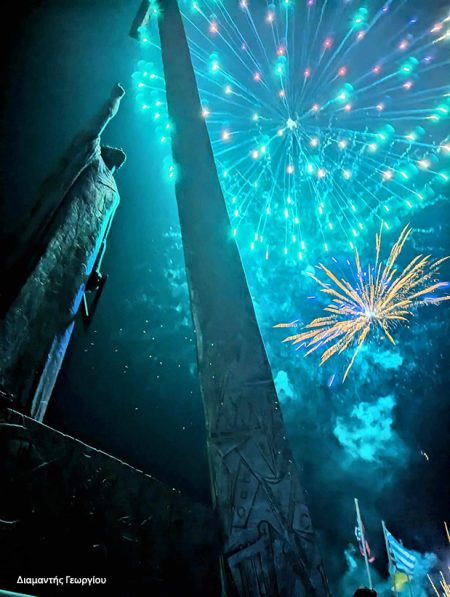Caves
Caves of Mytilinioi ancient quarries
In the Koutsodontis area of the village of Mytilinioi, at an altitude of 147 m, there are 45 caves which serve as entrances to an Ancient Mine. The entrances are supported by hand-carved pillars. One of the entrances leads into the interior of the hill, where a further eight levels were recorded, supported in the same way, with a total depth of –70 m and a length of 1 km per level.
In the Archaic period, materials were quarried here for the construction of the great Temple of Hera, as well as other buildings within the Sanctuary, and for the building needs of the ancient city of Samos.
During the Greek War of Independence in 1821, the caves were used as a “Saltpetre Mine”, where a monk named Ignatios prepared gunpowder using the nitrates.
Visiting the cave requires special equipment and must be done with a guide for safety reasons.
Jackal's Hole Cave of Pythagoras
Near Panagia Spiliani in Pythagoreio, at an altitude of 102 m, is the cave known as “Tsakalotrypa”. The cave is divided into two sections. The first section is about 50 m long and 5–8 m wide. The second section is reached through a narrow recess and is around 20 m long, 2 m high, and 3 m wide, sloping upwards towards the surface.
As with other caves on the island, a visit requires special equipment and must be made with a guide for safety reasons.
Cave of Panagia Sarantaskaliotissa and Cave of Pythagoras
This is a cave-chapel located on the western side of the island, near Marathokampos, at an altitude of 320 m. It takes its name from the forty old steps that lead up to the cave. The upper part of the cave branches into two chambers. The site is of historical, religious, and sporting interest. At its entrance stands a single-naved Byzantine chapel from the 11th century AD, decorated with post-Byzantine frescoes.
About 50 m from this cave, at the same altitude, lies the well-known “Cave of Pythagoras”. Access is by way of a short but slightly rough path, which begins midway along the stone-paved trail that leads to the Cave of Sarantaskaliotissa. According to local tradition, the philosopher Pythagoras hid here while pursued by the tyrant Polycrates. The cave is equipped with lighting.
Both caves attract large numbers of visitors.
Vrysoula Cave
Located in Pythagoreio, about 100 m south of Panagia Spiliani, at an altitude of around 90 m, this site is an old ground-level quarry for extracting rock. It measures approximately 90 × 60 m, with a height of about 5 m.
Its stalagmite formations are limited, and during the Second World War it served as a shelter. A distinctive feature is the appearance of stalagmites of various sizes across the floor, formed by abundant dripping water from the roof.
"Nerotrouvia" Caves
In the area of Myloi, three caves have been identified: Nerotrouvia I, II, and III. They are reached via a dirt road that passes through the village. Cave I, the largest, is a complex horizontal cave extending over three levels. Its entrance is about 3 m deep.
The first level is divided into several chambers, with a total length of 60 m and a rich decoration of stalagmites and stalactites. A striking feature is the formation known as the “Owl with its Pedestal”.
On the second level, a borehole pipe can be seen, which draws water for the water supply of Myloi. The cave here has a spongy and labyrinthine stalactite decoration.
On the third level there are water cisterns, which in earlier times would overflow.
"Xafakia" Cave
Located at the site of Xafakia, above Klima beach near Poseidonio, on the top of a hill, this cave has an entrance in the form of a small opening measuring 50 × 60 cm, from which warm air emerges in winter.
It lies at a depth of 45 m and features an impressive decoration of stalagmites and stalactites, reaching a height of 35 m. The cave has a bell-shaped form, with a length of about 70–80 m and a width of 40 m, richly adorned with strikingly white stalagmite formations.
"Siderenia porta" Cave
Located in Marathokampos, 600 m below the chasm-cave of Sarantaskaliotissa, at an altitude of 130 m, this cave is situated on a steep slope, making access difficult. Its decoration is remarkable, with tall stalagmite columns, helictites, eccentric formations, and basins.
The cave has been known since ancient times and was probably inhabited as a hermitage during the Byzantine period. In the era of the Principality, an iron gate was placed at its entrance to protect its formations.
Visitors may also encounter wild goats, which take refuge inside the cave.
"Sarantaskaliotissa" Cave
Situated north of Marathokampos, at the foot of Mount Kerkis, this cave is accessed by a paved road from Marathokampos, followed by a climb of around 100 stone-built steps.
At the cave entrance stands a small barrel-vaulted chapel of the Byzantine period, dedicated to the Virgin Mary. Inside, fragments of wall paintings survive in poor condition, most of them covered by a layer of lime plaster. Beyond the chapel, the cave divides into two chambers which end in shafts.
The first chamber, on the left, has a depth of 70 m, while the second reaches a depth of about 40 m. In the second chamber there is an artificial cistern for collecting water, in use since ancient times. At its far end, visitors can admire a notable display of stalagmites and stalactites.
"Pythagoras" Cave
Βρίσκεται 70 μ. μακριά απ’ το σπηλαιοβάραθρο της Σαραντασκαλιώτισσας και λίγο ψηλότερα απ’ αυτό. Η πρόσβαση σ’ αυτό γίνεται από ένα δύσβατο μονοπάτι και απαιτεί αναρρίχηση στο τελευταίο τμήμα της. Το σπήλαιο έχει διαστάσεις μήκους 70χ 10μ. πλάτους και ύψος οροφής γύρω στα 6μ. Υπήρχε μια μικρή αίθουσα 3χ3μ. περίπου που η είσοδος της φαίνεται λαξευμένη σε σχήμα ορθογωνίου τριγώνου. Η είσοδος του σπηλαίου έχει κυκλική μορφή. Κάτι που δεν το έχουμε συναντήσει σε κανένα άλλο σπήλαιο, είναι ένα λιθάρι περίπου 1,30μ, ύψος που έκλεινε την είσοδο του σπηλαίου. Ιδιαίτερο χαρακτηριστικό έξω από το σπήλαιο είναι ένας τρύπιος βράχος ύψους 10μ.περίπου. Σύμφωνα με ένα βιβλίο 200ετών περίπου που βρέθηκε στα χέρια ενός τσαγκάρη στη Κάλυμνο αναφέρει ότι ο Όσιος Παύλος ο Λατρινός ήρθε στη Σάμο το 930μ.χ να μονάσει στη σπήλια του Πυθαγόρα. Ως εκ τούτου συμπεραίνουμε ότι ό Φιλόσοφος Πυθαγόρας λίγο πριν φύγει για τον Κρότωνα έμεινε στη σπηλιά αυτή. Και ότι ο Παύλος ο Λατρινός είχε γραπτές πληροφορίες που τον οδήγησαν στο σπήλαιο αυτό με τα ιδιαίτερα χαρακτηριστικά που αναφέραμε.
The Cave of "Tzetzes"
Near the village of Kosmadaioi, at an altitude of 500 m, lies the Cave of Tzetzes. Access is relatively easy. The cave measures 40 × 25 m, with a depth of 20 m, and extends over two levels.
It consists of a large main chamber with interesting stalactite and stalagmite formations on its walls, as well as natural basins collecting water. According to reports, it has significant anthropological interest, and further exploration may yield important findings.
The Cave of St. Anthony
This cave lies a short distance from Old Karlovasi and is reached by a paved road from the era of the Principality. It measures 60 × 40 m. From the entrance, a 17 m long, 5 × 5 m passage leads to a spacious chamber of about 100 sq. m. At its centre stands a small chapel dedicated to St. Anthony.
Two additional small chambers, with a combined length of 20 m, also contain stalactites and stalagmites.
The Cave of "Megalo Seitani"
This cave of anthropological interest was used as a dwelling and place of worship during the Neolithic era, some 7,000 years ago. Its access and entrance are both very difficult and dangerous. It lies to the left of the gorge of Megalo Seitani.
The entrance measures 2 × 2 m, leading to a first chamber about 15 × 10 m. In 2016, a large section of the cave was discovered, inhabited in the Neolithic period, with many small and large chambers and rich speleothem decoration.
Finds included human skeletons embedded in the cave walls, everyday pottery vessels (including one fixed within a stalagmite), traces of fire, tools, and animal bones. Following excavations by the Ministry of Culture, all finds were transferred to laboratories for study, which promises to provide a wealth of information about the lives of Samos’ earliest inhabitants.


